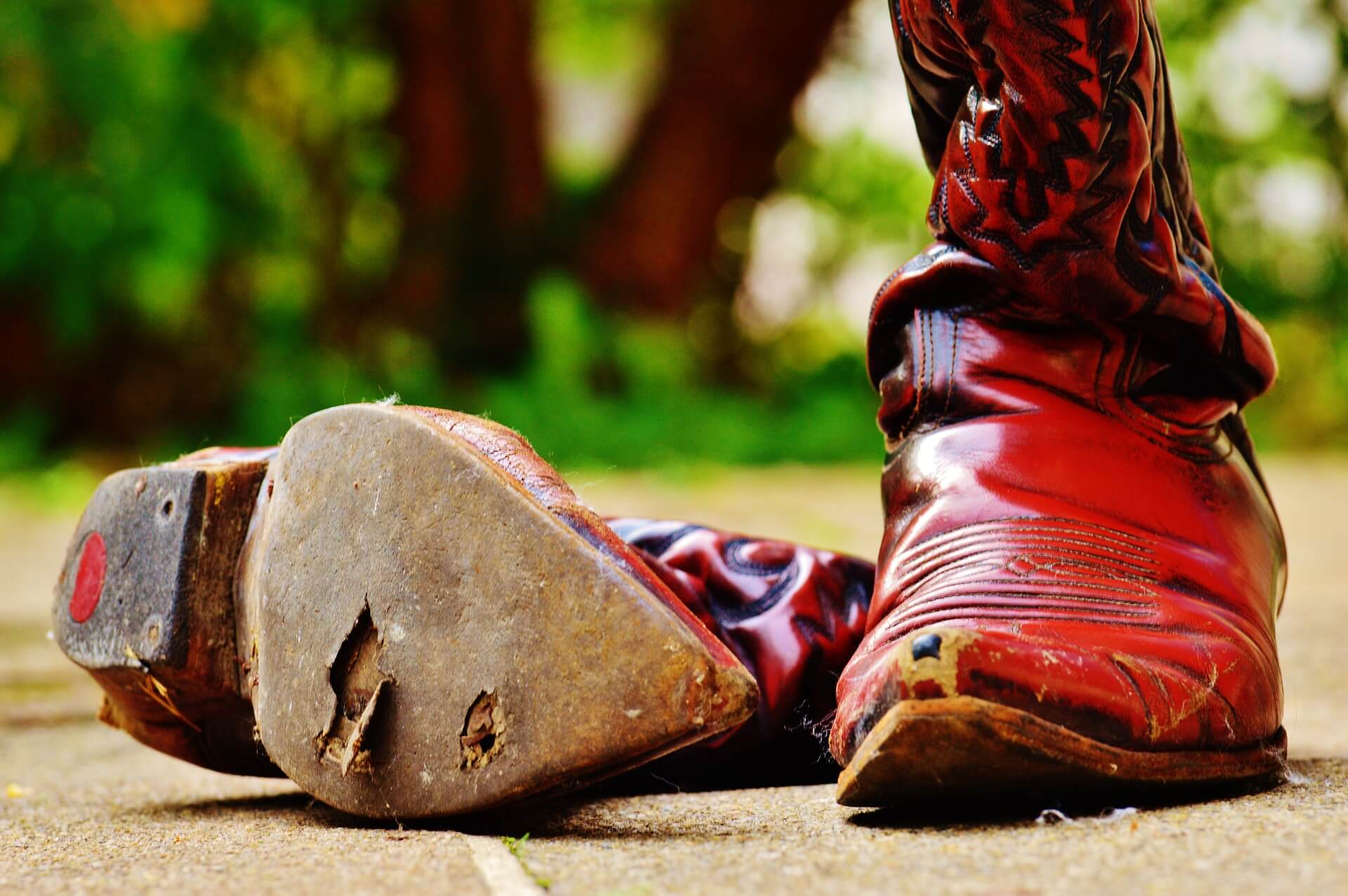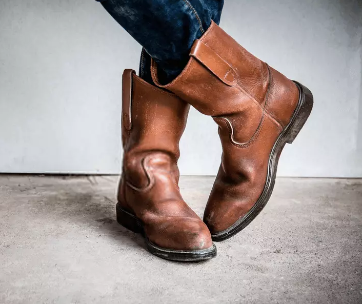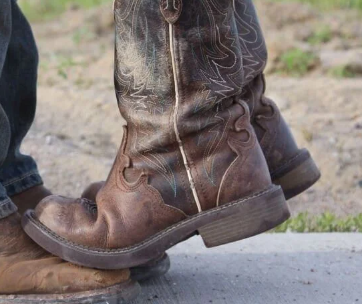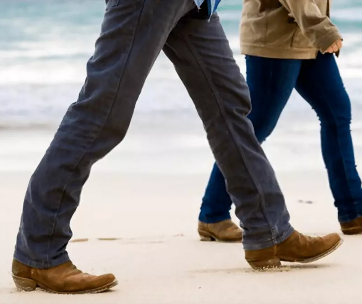A lot of things can be said about cowboy boots but one thing’s for sure; a high quality pair of western boots is a great investment.
So, do you want to get your money’s worth? It’s simple; take great care of them. Want them to serve you long-term? Again; care for them.
You see, it really doesn’t matter whether you just bought your first pair of cowboy boots or whether you just got the 10th pair that you intend to add to your boot collection- the same rule applies; you will need to actively take measures to care for your boots and maintain them.
And the measures aren’t even extreme. Through simple steps that you can easily do at the comfort of your home, the great condition of your boots can be preserved.
As experienced cowboy boot owners, this is a mantra that we live by “if you take care of your boots, they will surely take care of you.”
That said, here are our eight golden rules of cowboy boot care;
1. Waterproof Your Cowboy Boots
If you live in wet conditions, then your shoes are susceptible to damage from water and the last thing you want to do is ruin those beloved boots.
The thing about water is that it diminishes the integrity of the leather such that lengthy exposure to moisture can result in stretched, cracked and/or discolored leather. Not only does the shape and color of the leather weaken but it also comes with a certain musky smell to it; owing to growth of mold and mildew.
Here’s what you ought to do to avoid that;
Use waterproofing sprays
New leather boots require protection from the elements.
As such, applying a waterproofing spray is a proactive measure that will protect them in case of any contact with water.
The spray offers a slick, clear, water repellent surface that protects the leathers from water damage as well as other stains. It also makes it easier to wipe off mud as it doesn’t allow it to penetrate into the fibers of the leather.
To spray, place the boots over a newspaper outside or in open/ well-ventilated room.
Next, use a polymer silicone spray and spray it evenly over the surface of the boots holding it about one foot from the boot.
Note that while silicone sprays are great for suede or nubuck leather boots, they tend to have a drying effect hence should be used sparingly.
Allow the boots to dry for about half an hour then apply a second coat for extra protection and give the boots another 30 minutes to dry. The boots should be ready to wear once dried.
Your leather boots, be they new or old, require this protection so spray regularly (every month), especially if you reside in wet areas.
As for those who reside in dry areas and the occasional wearer, you may not need to spray them as often, so every three months should do.
The good thing about this process is that it is so quick that within an hour you will be rewarded with boots that can withstand the elements and last for decades.
Of course, that’s if you do so regularly.
Apply Mink oil on leather soles
Compared to waterproofing with spray protectant, the process of applying mink oil is a little more time-consuming. But on the bright side, this application makes of a lengthier life span for your boots so it’s a win-win.
Mink oil contains fatty acids that make the leather supple and protect it from any scrapes. As you know, water and oil do not mix so mink oil protects the leather from water and prevents development of cracks in the leather.
To apply, gently massage the oil into the leather, soles and heels of the boots and set it in the sun in order for the leather to soak up the oil deep into its fibers. Then wipe off any excess oils and allow the boots to dry naturally.
This process is especially helpful with smooth leather boots and should be applied regularly to prevent the leather from drying out.
2. Clean the Boots
I’m sure you’ve heard it over and over again till it’s become a song in your mind. But there is truth in old adages, such as “dirt and dust are your boots worst enemy”.
And the truth in that statement cannot be undermined. Dust and dirt will indeed wear out your boots faster than any other substance that your boots get exposed to.
They may seem harmless but dirt and dust usually cut into the microscopic fibers of your leather; drying them out and making them weak.
That is why, as you will notice, before any boot-care process, you will need to ensure that your boots are free from dirt and dust.
Routinely clean the boots
During rainy season, the dirt residue if left un-cleaned can damage not only the leather but also the metallic parts of your boots such as zippers (if any).
And during winter, it’s even worse as your boots get exposed to salt and chemicals which stain them leaving large white crusts.
Start by brushing the boots then follow that up by wiping over the surface with a soft cotton cloth. This will get rid of any loose dirt on the surface.
Use a toothbrush to work over any debris that tends to settle in the seams and creases of the boot. This is especially important for exotic leather which have deeper and more detailed folds where dirt tends to hide.
In the event of ingrained dirt and grime you will need saddle soap or a leather cleaner to effectively clean the boots.
That’s it! Just remember to routinely clean your boots with a damp cloth as soon as you get home (after every wear) to get rid of any dirt and residue.
3. Condition the Boots
Here’s why conditioning is so important; because moisture and dry air can dry out the boots (especially at the stress points), your boots need a moisturizer that will replenish the leather to prevent it from cracking and splitting.
The conditioner keeps further the leather young and pliable so be sure to apply it every month if you wear the boots regularly.
Again, before any process, be sure that the boots are clean. This is to prevent the conditioner from trapping the dust inside where they can cause further damage.
Next, apply a lanolin-based leather condition onto a soft clean cloth and massage the conditioner into the boot in gentle back and forth/ circular motions.
Note that, lanolin based conditioners help retain the color and finish of the leather.
You should use oil based conditioners on dark boots or those with an oiled finish. The conditioner will prevent water from seeping into the fibers of the leather as oil naturally repels water.
Another thing you need to take note of is to always work with/for the grain of the boot rather than against it.
That said, the amount of conditioner you will use varies from boot to boot in that the drier the boot the more conditioner you will need to apply.
On the initial application, the leather will soak up the conditioner so you will be able to tell if the boot has had enough once it stops absorbing the conditioner and lets it sit on top in a thin layer.
Allow the boots to dry for 12 to 24 hours and wipe any excess conditioner with a dry rag
You will notice a subtly darker coloration of the leather, but that’s absolutely normal. For leather soled boots, use an edge dressing around the sole to prevent moisture from seeping in.
4. Polish the Boots
If your boots have a finish, then polishing them will help maintain their shine. The polish also help get rid of scratches, scuffs and marks so you should make a mental note to seal in the cracks with it.
Beforehand, wipe any over-laying dirt that may have accumulated in between your boot care process.
To maintain that shine apply a cream leather polish onto a clean cloth and run it into your boots.
You want to always use a neutral polish or one that matches the color of your boot to avoid discoloration.
If you prefer a high gloss shine, you might have to add the polish. Just be sure to buff the boots between each layer of polish till you get your desired finish and thoroughly wipe off any excess polish.
5. Allow the Boots to Dry Naturally
Whether you’re just done cleaning, conditioning and polishing the boots, or your boots got wet naturally from heavy rains, a puddle or day at the ranch, do not be tempted to use artificial heaters to fasten the drying process.
Artificial heat sources such as a blow dryer, fireplace, heater vent, and wood burning stoves will ruin your boots in the long-run as high heat usually melts any protectants you may have applied to the boots.
Of course they will dry faster but this does nothing to the longevity of the leather as the process dries them out and eventually leads to cracking of the leather.
Ensure the boots are completely dry before re-wearing
Remember, this natural drying process takes time so give the boots time to dry in a warm dry place with good ventilation any time they come into contact with water/ moisture.
For contact areas such as the sole, if you continue to wear your boots before they dry out completely, the wetness may eventually split the soles from the rest of the boots.
The thing is that when exposed to water, the leather soles tend to soften so allowing them to dry thoroughly gives the leather time to re-harden and makes it less likely to wear.
In the event of water-logged boots that are not waterproofed, use a towel to soak up the moisture then allow them to dry naturally.
And if the water somehow got inside the boots, stuff newspaper inside the boots to seep the water and dry the interior.
If nothing else; always ensure your boots are completely dry before a second wear.
6. Store the Boots Properly
While you may be accustomed to carelessly tossing your other shoes in the closet after spending time in the outdoors, a true cowboy knows that extra care needs to be taken with cowboy boots.
Truth is that a lot of the times, your storage space always dictates your storage methods. But however minimal the space is, your boots have to be stored with care. To do that;
Store the boots away from moist areas
Second to dirt in terms of boot damage is moisture.
As we’ve mentioned repeatedly, too much water can prove to be hazardous to your boots.
Storing them in a damp area is not even up of discussion so be sure to store the boots in a well-ventilated room in order to retain their color as well as the leather consistency.
While you want them to breathe, you also do not want the boots to become moist and grow mold or mildew, so keep them away from humid areas such as bathrooms, leaky rooms and leaky windows to increase their shelf life.
Store the boots away from light
The internal fibers of leather usually dry out and crack from overexposure to the sun’s UV-rays, ultimately aging the leather and discoloring them.
In order to preserve the oils in the leather as well as its fibers; the conditions where the boots are stored need to be optimal.
So even if you intend to keep the boots aired, ensure that they are not in an area where the windows will get direct exposure to the sun.
This means away from direct sunlight especially for exotic skins which tend to wrinkle out fast.
Store the boots in an upright position
The folds and creases that quickly age boots can be avoided by storing the boots in an upright posture.
Of course, the boot will crack as the leather molds to the shape of your feet and walking style but other areas are also prone to creasing and that can be avoided.
Upright storage also helps ALL parts of the boot to breathe rather than limiting the parts that are folded over and giving way to growth of mold. This form of storage can be held in several ways.
One of our favorite is the boot tree.
A boot tree will not only deter any folding but it also absorbs moisture without dehydrating the material in addition to maintaining the shape of the boot.
Not to mention that cedar boot trees will do so while ensuring that the boots are free from any odor.
Another option is boot racks and boot shapers which will prevent slouching especially at the ankle point.
As you may or may not know; once broken in, the leather of cowboy boots usually softens to an extent where it won’t case blisters to your feet but it will definitely be soft enough to give in to the weight of the shaft with time.
The slouching at the ankle happens when the shaft collapses due to improper storage. Boot shapers and boot racks act as a skeleton and thereby ease the strain one the ankle.
You can also use swimming pool noodles to help keep the leather of your boots straight. Regardless of the method you deem more suitable for you, just ensure that the boots do not lean onto one another and collapse.
Store the boots in a safe place away from pets
It goes without saying that dogs love to chew on stuff, especially leather which smells like wildlife.
As a bonus, store the boots where they are out of reach of pets such as dogs that like to chew and damage the leather of the boots.
When the boots are safe, they won’t be damaged.
7. Repair the Boots
Listen, even if you take all the above steps, the shoes are still prone to aging especially if you wear them regularly and they’ve served you for years on end.
And the tell-tale signs are always there if you care to check. For instance, worn out or run-down soles can be seen based on the thickness of the sole and heels damaged can be felt if they start to feel a little loose.
Replace soles and heels
If you tend to be hard on footwear then your soles may need replacement more often than that of others.
Not only that, the leather that sits next to the soles and heels may also need repairing.
You should replace the rubber on the heels before it wears down to the leather.
The heels and soles might need repairing, but once done, your boots will be good as new, especially if you’ve taken great care of them. So take the boots to the local shoe repair shop and have them resoled before it’s too late.
Use Vibram rubber on the bottom sole
If you tend to be really hard on your feet or tend to walk around a lot on pavement, then a rubber Vibram sole may be useful. It overlays on the sole such that it shields the actual sole from damage.
What we especially love about this is that it saves you money as you need not resole as often and extends the life of the sole and general lifespan of the boots.
8. Invest in Boot Jacks and Boot Bags
There are a lot of products that are geared towards lengthening the life of your boots. Our favorites are boot jacks and boot bags.
Here’s how you should use them;
Remove boots using boot jack
Every cowboy boot owner knows that removing the boots can be quite challenging; especially in the absence of lacing.
Even with a loose fit at the top, most people tend to use one boot over the other to remove it.
Instead of wrestling one boot off the other using the heel and eventually causing damage to the leather, a boot jack can be used to automatically remove the boot.
This gear saves on time and what’s more; it won’t damage the leather of your boot.
Use a boot bag when travelling
Rather than shoving the boots into an already squeezed suitcase and make it prone to damage, you can opt for a special boot bag
These bags are designed to store the boots in an upright position, where they won’t fold
So not only do bot bags help retain the shape of the boot but they also save on money that you would otherwise use to repair any damage.
Bottom Line
Boot care isn’t as hard as others may make it out to be.
With consistency, it can easily become a habit that you will appreciate over time.
To sum it up, make it a habit to regularly weather-proof, clean, condition, polish your boots. Be sure to also properly store the boots straight, in a temperature controlled area to curb high humidity, away from direct sunlight and potential harm from pets in order to get the most out of them.
Do this and your boots will stay with you for years upon years; always look young as ever.








Comments